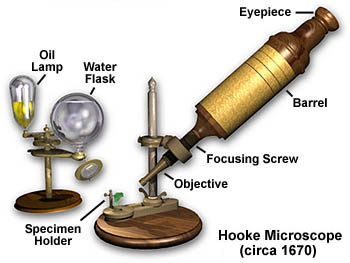Hooke's Microscope
This beautiful microscope was made for the famous British scientist Robert Hooke in the late 1600s, and was one of the most elegant microscopes built during the period. Hooke illustrated the microscope in his Micrographia, one of the first detailed treatises on microscopy and imaging.

Although Hooke did not make his own microscopes, he was heavily involved with the overall design and optical characteristics. The microscopes were actually made by London instrument maker Christopher Cock, who enjoyed a great deal of success due to the popularity of this microscope design and Hooke's book.
The Hooke microscope shared several common features with telescopes of the period: an eyecup to maintain the correct distance between the eye and eyepiece, separate draw tubes for focusing, and a ball and socket joint for inclining the body. The microscope body tube was constructed of wood and/or pasteboard and covered with fine leather. When the draw tubes were fully closed the microscope measured six inches long. Although the craftsmanship and design of this microscope was excellent, it suffered from a poorly executed focusing mechanism that would tend to wear very quickly and unevenly.
Hooke used a bi-convex objective lens placed in the snout and two additional lenses, an eyepiece lens and a tube or field lens. When combined, the lenses suffered from significant chromatic and spherical aberration and yielded very poor images. Hooke attempted to correct the aberrations by placing a small diaphragm into the optical pathway to reduce peripheral light rays and sharpen the image. Unfortunately, this resulted in very dark samples containing a significant degree of diffraction artifacts that, when combined with spherical and chromatic aberrations, seriously degraded the image quality. To combat dark specimen images, Hooke designed an ingenious method of concentrating light on his specimens, as shown in the illustration. He passed light generated from an oil lamp through a water-filled glass flask to diffuse the light and provide a more even and intense illumination for the samples. Even with all the intricate details involved with this microscope, it still fell short in optical performance when compared to the simple Leeuwenhoek microscope.
BACK TO SIXTEENTH-SEVENTEENTH CENTURY MICROSCOPES
